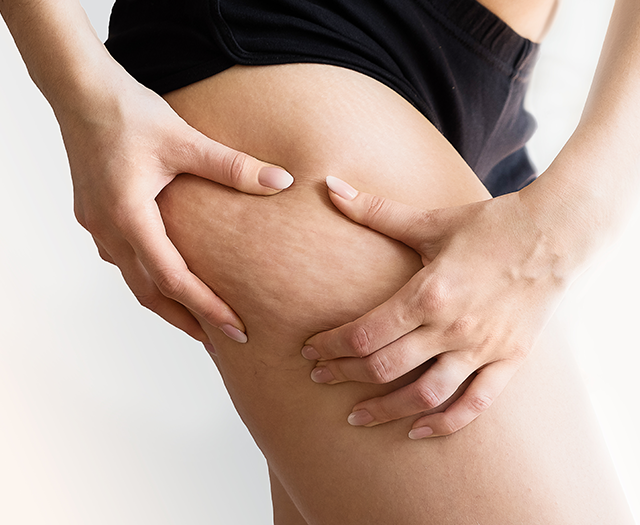Cellulite & Fat: Differences explained
Fat and cellulite are linked because they essentially have a cause-and-effect relationship. Ultimately, this relationship is demonstrated by how cellulite forms. Cellulite develops from the interaction of fat and connective tissue below the surface of the skin, most notably around the buttocks, thighs, and hips. Treatments that are able to effectively remove fat often have little to no effect on cellulite. This difference is important as results should be measured accordingly. Areas of cellulite have a dimpled appearance because of connective tissue that separates fat cells into different areas forming raised and depressed areas in the skin. The irregularity of the skin causes it to lose smoothness. As a skin surface issue, assessing cellulite is a challenge, and accurate visualization and objective parameters should be used for objective measurement in clinical studies.
Numerous treatment options
A variety of products and treatments for cellulite reduction has been made available; both invasive and non-invasive. Laser treatments, energy-based devices and mechanical treatments are among the many ways to treat cellulite. Cellulite treatment requires several sessions to reach efficacy. After one week, treatments are able to visibly reduce cellulite and subcutaneous thickness; and after six months for contour irregularities.
Cellulite evaluation techniques
Various photography systems have been utilized to evaluate cellulite on the thighs and buttocks, such as 2-dimensional and 3-dimensional photography systems. 2D photography is primarily used for qualitative assessment of cellulite. Primary Outcome Measures in most cellulite studies is based on a qualitative assessment of 2D photographs performed by a central blinded expert. Cellulite is rated on a scale for severity and overall improvement by comparing pre- and post-treatment using the Global Aesthetic Improvement Scale (GAIS).
3D analysis technology enables accurate measurements of straight lines, curved lines and closing surfaces. 3D technology compliment 2D for its ability to provide information on measurement contour irregularity and volumetric dimensions of dimple depressions and elevations. This level of visualization has provided an improved way of evaluating complex surface structures.
QuantifiCare’s technology
A pioneer in 2D/3D digital photography for clinical trials, QuantifiCare provides premium quality devices and a user-friendly software solution that integrates seamlessly into any aesthetics practice or laboratory’s workflow. The 3D LifeViz® Infinity offers unparallel reproducibility for the best quantitative measurements available. Portable and compact by design, it is able to support primary endpoints and produce quantitative data to support subjects. It is equipped with double flashes to ensure consistent lighting and good overall image reproducibility. Integrated dual-beam pointers allow standardization in the capture process in order to yield accurate image comparison.
With the new 3D Track™ tool, it has never been easier to detect and quantify straight lines, curved lines, closing and smoothed surfaces. Investigators are able to achieve effectively treatment efficacy by doing the following steps:
① 3D image registration/matching: Perfectly position tracings of 3 points on a reconstructed 3D image to achieve accurate matching.
② Volume map: 3D Track will automatically display the differences of negative and positive volume of dimples.
③ Digital tracings of dimples: Tracings are manually adjusted to more accurately match the contours outlined by the volume. The central operator can now propagate base line tracings on a follow-up visit image.
④ Export measurement data: Measure exploratory endpoints by:
Negative volume (mm3), Avg Depth (mm) and Area Skin Roughness (mm)
The 3D Track objectively evaluates cellulite with an extraordinary level of accuracy to determine changes in volume, surface and depth over time. The added 3rd dimension in the matching process brings about exceptional precision in the matching process, unmatched to 2D visualization techniques. Thanks to this added ability, contours can be accurately positioned on follow-up images, ensuring maximum reproducible measurements.
Macrophotography and 3D imaging are highly regarded as important methods to effectively quantify aspects of cellulite on the buttocks and thighs. The LifeViz® Infinity achieves global area evaluation while also targeting smaller regions of interested – all in a single system.

